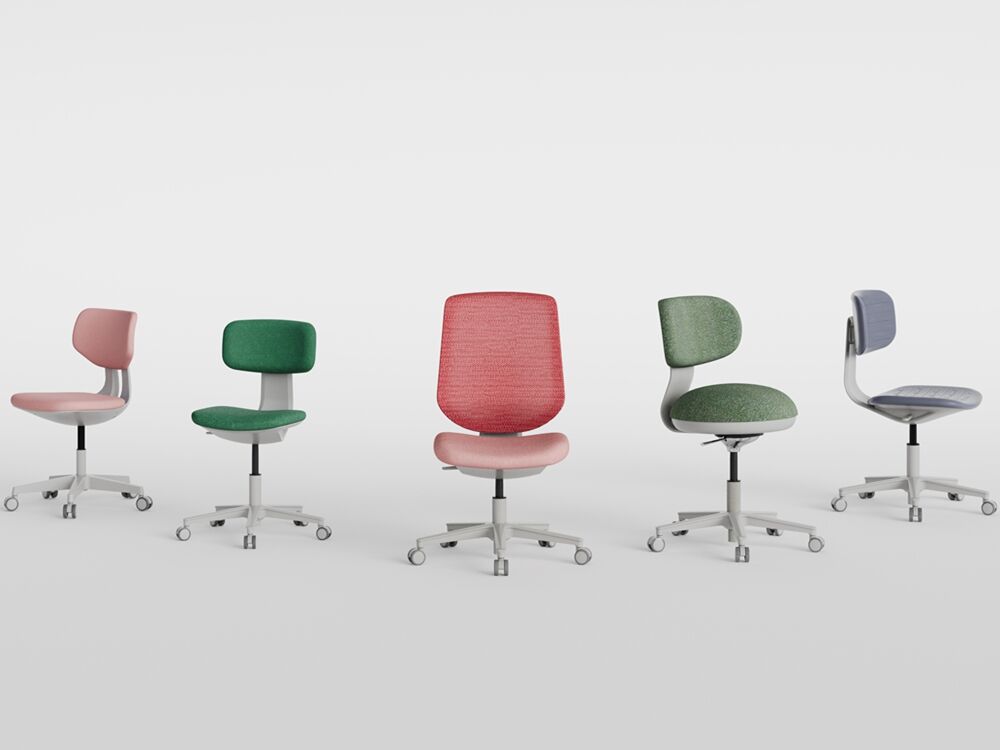
The Science of Breathability in Office Chair Materials
What Makes a Chair Breathable?
The concept of breathability in office chairs revolves around the material's ability to facilitate airflow and manage moisture, enhancing the user's comfort during extended work hours. Breathable materials allow for better air circulation, which is crucial for avoiding discomfort caused by heat buildup and perspiration. Different chair materials exhibit varying levels of breathability, influencing their suitability for prolonged use. For instance, a study highlighted in the Journal of Ergonomic Design emphasized the superior airflow rates in mesh chairs compared to leather and synthetic materials, underscoring their effectiveness in maintaining cooler seating conditions.
Breathability plays a significant role in user health by preventing sweat accumulation and promoting skin comfort. A lack of airflow can lead to overheating, resulting in uncomfortable sweating and potential skin irritations. Additionally, chairs that fail to effectively dissipate heat can cause fatigue, affecting workplace productivity. Thus, choosing a breathable chair material is not merely a preference but a necessity for maintaining a comfortable and healthy work environment.
How Fabric and Leather Differ in Airflow
Fabric and leather materials present distinct characteristics in terms of airflow and comfort in office chairs. Fabric materials, particularly mesh and cotton blends, are renowned for their high breathability. Mesh chairs, for instance, offer remarkable ventilation, allowing for consistent air circulation around the body. This feature makes them ideal for hot climates or offices lacking robust air conditioning.
Conversely, leather is known to reduce airflow due to its dense and less permeable nature. Full-grain leather, while luxurious, tends to trap heat and contribute to sweat buildup during long hours of use. Synthetic leathers, such as bonded leather, often attempt to balance the elegance of leather with improved breathability, yet they may still fall short compared to fabric options. Experts argue the trade-offs between comfort and functionality in different office settings often drive the decision between these materials. Innovations in fabric technology continue to emerge, focusing on enhancing breathability without compromising durability, signifying a progressive stride toward more ergonomic office furniture solutions.
Fabric Office Chairs: Breathability Benefits Explained
Material Composition and Airflow Efficiency
When it comes to breathable office chairs, fabric materials offer a distinct advantage. Fabric office chairs typically utilize materials like polyester, nylon, cotton blends, and others, which are renowned for their airflow efficiency. These materials allow air circulation, aiding in the prevention of heat and moisture buildup. Studies highlight the superior breathability ratings of mesh fabrics, which are woven to create an open structure. This design ensures excellent airflow efficiency, encouraging cooler seating despite extended hours at a desk. Furthermore, the texture and weave of these fabrics play vital roles; smoother textures offer less resistance to airflow, enhancing breathability. Popular examples of fabric office chairs that excel in breathability include models like the Herman Miller Aeron Chair, recognized for its airy mesh back and seat design, which maintains comfort during prolonged sitting periods.
Ideal for Warm Climates and Long Work Hours
Fabric office chairs serve as ideal seating options for warm climates, thanks to their moisture-wicking properties that ensure users remain cool and comfortable. In warmer environments, individuals can experience temperature-related discomfort, making the breathability of fabric chairs crucial to maintaining productivity and focus. Numerous testimonials vouch for the enhanced comfort attributed to these chairs, especially during extended work hours. Users have reported reduced sweating and increased comfort due to the breathable nature of fabric materials, which facilitate efficient temperature regulation. For those working in warm climates, recommendations suggest considering office chairs with mesh or breathable fabric upholstery to maximize comfort. Products such as the Herman Miller Aeron Chair and HON Ignition 2.0 are specifically praised for their suitability in warm conditions, offering excellent breathability and ergonomic support.
Leather Office Chairs: Style vs. Ventilation Trade-offs
Why Leather Traps Heat
Leather office chairs, renowned for their elegance, are less celebrated for their capacity to retain heat. This heat retention is primarily due to leather's natural insulation properties, which can inhibit airflow compared to fabric counterparts. Unlike fabric office chairs, which promote airflow due to their breathable fibers, leather tends to trap body heat, leading to discomfort during prolonged use. In warmer climates or poorly ventilated spaces, the thermal resistance of leather can be more pronounced, leading to sweaty and uncomfortable sitting experiences over extended periods. To mitigate these thermal disadvantages, one may consider using cooling pads or improving air circulation within the room. Incorporating such adjustments can significantly enhance the comfort of using a leather chair without sacrificing style.
When Leather Might Still Work for Your Office
Despite the challenge of heat retention, leather office chairs remain a favored choice in many office environments. Their aesthetic appeal and professional appearance can outweigh ventilation concerns, particularly in client-facing or executive settings where first impressions are crucial. Leather chairs are often preferred for their sophisticated look and durability in such scenarios. Furthermore, innovations like perforated leather designs have been developed to improve airflow while maintaining the luxurious feel that genuine leather offers. User feedback frequently highlights the impressive functionality and long-lasting appeal of leather chairs, even in environments where some ventilation trade-off exists. For aesthetic-driven office settings, these chairs not only offer a touch of elegance but also adapt to various office designs while ensuring comfort and style.
Ergonomic Design and Breathability in Different Chair Types
How Breathability Complements Ergonomic Support
Breathability in an office chair is integral to ergonomic design, enhancing both comfort and productivity. Ergonomic principles involve aligning with the body's natural posture, offering support that mirrors our physiological structure. A critical yet often overlooked aspect is breathability, which ties directly into this support. Studies show that breathable materials, like mesh, help regulate body temperature during prolonged sitting, preventing discomfort from heat buildup. For anyone purchasing an ergonomic chair, it's essential to prioritize options that focus on effective air circulation. This assists in maintaining optimal body temperature and encourages varied postures, preventing fatigue and boosting productivity. When selecting an ergonomic chair, ensure it provides not just structural support but also the necessary airflow to keep you cool and comfortable.
Mesh vs. Fabric: Secondary Breathability Options
Mesh and fabric chairs are popular for their breathability, each offering unique features. Mesh chairs are renowned for their breathability due to their open weave structure that allows constant airflow, making them ideal for warmer climates or long hours of use. On the other hand, fabric chairs provide a softer feel and can offer a balance between comfort and temperature regulation. For individuals seeking ergonomic benefits, features like adjustable lumbar support and adaptable components enhance overall comfort. User reviews often highlight mesh chairs for their airy comfort while traditional fabric models are praised for their warmth and versatility. Current trends in office furniture are moving towards innovative designs utilizing blends of mesh and fabric materials, effectively maximizing breathability and providing ergonomic support. For office chair purchasers, exploring these materials and technologies can lead to finding a chair that meets both ergonomic and comfort needs.
Making the Right Choice: Factors Beyond Breathability
Durability and Maintenance Comparisons
In considering an office chair's durability, breathability plays an intriguing role. Breathable materials often influence how long a chair lasts and its upkeep. For example, leather chair surfaces are well-known for their long-lasting quality, easily cleaned with a damp cloth or leather conditioner to prevent cracking. However, they might be vulnerable to scratches and direct sunlight, requiring protection to maintain their elegant finish. On the other hand, fabric chairs, while offering diverse colors and patterns, may tend to show wear and tear more prominently. They demand regular vacuuming, steam cleaning, and protective treatments to preserve their look and offer fewer inherent maintenance benefits compared to leather, which inherently resists dust and allergens. User experiences frequently mention that a well-maintained leather chair provides a timeless appeal over the years, while fabrics allow for more dynamic visual updates.
Cost Considerations for Budget-Conscious Buyers
When planning a purchase, it's essential to weigh the cost implications of chair materials. Various price ranges exist for breathable fabric chairs compared to leather, with leather often demanding a higher upfront investment. However, its longevity can render it more cost-effective long-term. Leather chairs are valued for their durability and low maintenance, which can justify the initial expense. In contrast, fabric chairs are attractive due to their affordability, with many budget-friendly options not sacrificing style or breathability. Experts often emphasize seeking quality breathable fabric chairs over cheaper counterparts that might compromise on airflow and comfort. For budget-conscious buyers, looking for sales or discount outlets could yield competitively priced chairs that maintain both comfort and design integrity.
By considering these factors, individuals can make informed decisions, balancing their budgetary constraints with needs for durability and aesthetics. Whether opting for a luxurious leather office chair or a versatile fabric model, assessing both short- and long-term costs is key to achieving satisfactory results.










